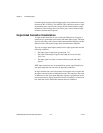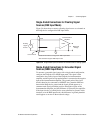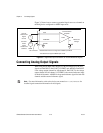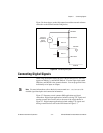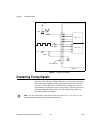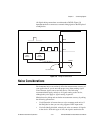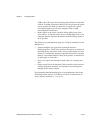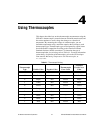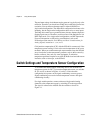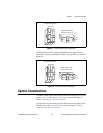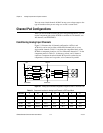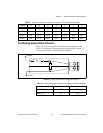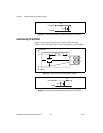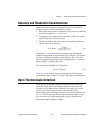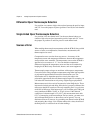
Chapter 4 Using Thermocouples
SCB-68 Shielded Connector Block User Manual 4-2 ni.com
The maximum voltage level thermocouples generate is typically only a few
millivolts. Therefore, you should use a DAQ device with high gain for best
resolution. You can measure thermocouples in either differential or
single-ended configuration. The differential configuration has better noise
immunity, but the single-ended configurations have twice as many inputs.
The DAQ device must have a ground reference, because thermocouples are
floating signal sources. Therefore, use bias resistors if the DAQ device is in
DIFF input mode. For a single-ended configuration, use RSE input mode.
For more information on field wiring considerations, refer to the
NI Developer Zone tutorial, Field Wiring and Noise Considerations for
Analog Signals, located at
ni.com/zone.
Cold-junction compensation (CJC) with the SCB-68 is accurate only if the
temperature sensor reading is close to the actual temperature of the screw
terminals. When you read thermocouple measurements, keep the SCB-68
away from drafts or other temperature gradients, such as those caused by
heaters, radiators, fans, and very warm equipment. To minimize
temperature gradients, keep the cover of the SCB-68 closed and add custom
insulation, such as foam tape, to the SCB-68.
Switch Settings and Temperature Sensor Configuration
To accommodate thermocouples with DAQ devices, the SCB-68 has a
temperature sensor for CJC. To power the temperature sensor, set switches
S1, S2, and S3 as shown in Figures 4-1 and 4-2. Notice that this
configuration also powers on the signal conditioning accessory power.
Signal conditioning accessories include temperature sensors and signal
conditioning circuitry.
For single-ended operation, connect referenced single-ended analog
channel 0 to the temperature sensor by switching S5 to the up position.
The signal is referenced to AIGND. Set the switches as shown in
Figure 4-1.



